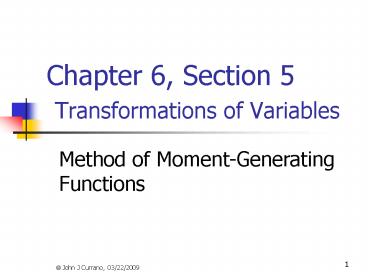Chapter 6, Section 5 Transformations of Variables - PowerPoint PPT Presentation
1 / 13
Title:
Chapter 6, Section 5 Transformations of Variables
Description:
Method of Moment-Generating Functions. The crucial theorem is: ... X and Y are random variables which both have moment-generating functions, and if ... – PowerPoint PPT presentation
Number of Views:42
Avg rating:3.0/5.0
Title: Chapter 6, Section 5 Transformations of Variables
1
Chapter 6, Section 5 Transformations of Variables
Method of Moment-Generating Functions
? John J Currano, 03/22/2009
2
Method of Moment-Generating Functions The crucial
theorem is Theorem 6.1 (p. 318) If X and Y are
random variables which both have
moment-generating functions, and if mX(t)
mY(t) for all t in some interval around t
0, then X and Y have the same probability
distribution.
3
- Method of Moment-Generating Functions
- Some other useful facts
- If U aY b, then
- If Y1, Y2, , Yn are independent and U Y1 Y2
???? Yn, then
by independence
4
4. If Y1, Y2, , Yn are independent and
identically distributed (iid) with common
distribution Y, i.e., a Random Sample from Y ,
and U Y1 Y2 ???? Yn, then
5
Method of Moment-Generating Functions
Example 1. Suppose that Y1, Y2, , Ym are
independent binomial RVs with Yi bin(ni, p)
same p. Then for i 1, 2, , m,
6
Example 2. Let Y NegBin(r, p), X0 0,
and Xi of trial on which i th success
occurs. Then Yi Xi ?? Xi?1 Geom(p) for
i 1, 2, , r, and Y1, Y2, , Yr are
independent. Also,
Thus, by Property 2 on slide 3. We
have found the moment-generating functions of the
negative binomial distributions using those of
the geometric distributions.
7
(No Transcript)
8
Example 3. Let Y N( ?, ? 2) and Then
so by Property 1 on slide 3
So Z N(0, 1) Z has a standard normal
distribution. Transforming a random variable Y
by subtracting its mean and dividing by its
standard deviation is called standardizing Y.
9
Example 4. Let Z N(?0,1) and Y ? ? Z
. Then
so by Property 1 on slide 3
So Y N( ?, ? 2) Y has a normal distribution
with mean ? and variance ? 2. Transforming a
standard normal random variable Z in this
fashion is a way of simulating other normal
random variables.
10
Example 5. If Yi N( ?i , ? i 2) are
independent for i 1, 2, . . . , n, then
for 1?? i ? n. Let
Then by the Property 3 on slide 4,
so Y N Thus, a linear combination of
independent normal random variables is also
normal.
11
Special Case. Suppose Y1, Y2, . . . , Yn are a
random sample from a N( ? , ? 2) -
distribution, and the sample mean.
Thus the sample mean of a random sample of size n
from a normal distribution also has a normal
distribution. Its mean is the same as that of
the original distribution and its variance is
smaller ? ? 2/n instead of ? 2. This will be
used often next semester.
12
(No Transcript)
13
The integrand is proportional to the density
function of the normal distribution with ? 0
and ? 2 (1 2t)?1. Thus, if we multiply by
inside the integral and by outside, we obtain
Thus,

